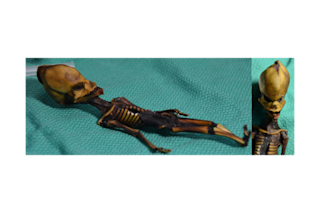Smaller than a Barbie doll, with an elongated skull and other anomalies, the mummified skeleton known as “Ata” was found in an abandoned mining town in Chile’s Atacama Desert in 2003. And since then, there has been no shortage of theories about the individual, many of them suggesting an otherworldly origin. A study out today answers several of the questions swirling around the remains.
You may have become acquainted with the Atacama “alien” through 2013’s Sirius, which focused on assorted UFO and alien-centric conspiracy theories. Stanford University researcher Garry Nolan and colleagues subsequently did an examination and some DNA analysis on the skeleton and established it was human, though at the time they were unable to explain its size and other multiple physical anomalies.
Today, thanks to high-quality DNA extracted from bone marrow, Nolan and colleagues describe numerous new details about the individual determined by whole genome sequencing.
One of ...














